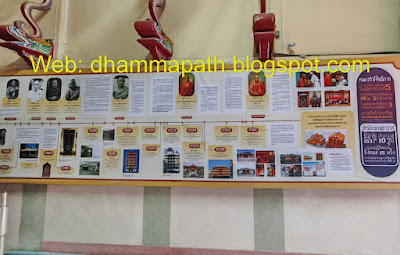I had the opportunity to pay respect to the Phra Rod Luang image in Wat Mahawan. It was considered a blessing to come to pay respects to the Buddha image and make merit at the temple that is known for the most Auspicious Phra Rod in Thailand. Wat Mahawan was originally named Wat Mahawannaram. This temple was built around 1204 during the reign of Queen Chamadevi, the first monarch of Hariphunchai, Wat Mahawan is not only the royal temple of Queen Chamadevi, but also the place where Phra Rod, the first Benjapakee Buddha amulet created in the world, is enshrined. It is also the place where the sacred relics of the Buddha or as people generally call them, “Phra Rod Luang”, are enshrined.
The 2 Giant Singha statues venerated at front entrance of Wat Mahawan.The sacred Phra Lersi statue.
The sacred Phra Rod Luang statue of Wat Mahawan.
Photo taken in front the Ubosot Wat Mahawan. Built during the time of Kruba Upanan, the abbot. The year is unknown. It was renovated many times until Phra Khru Phisan Thammanitet (Charoen Chotitharo) demolished it and rebuilt it in 1994. It is 25 cubits and 58 wide. It took 4 years to build and was completed in 1998.
The principal main Phra Buddha Paramaravijaya was built in 1620 by Phraya Sapphasit. At the front side is venerated Phra Rod Luang, is a Buddha image made of black stone, 17 inches wide at the lap, 36 inches high, sitting in the diamond meditation posture, enshrined by covered with Golden, located in front of the principal Buddha image in the temple. It is a Buddha image that Queen Chamadevi invited from the city of Lavo around the year 1204.
The statues of past abbot Wat Mahawan.
Golden Phra Rod Luang statues.
Mural painting inside Ubosot wall.
The new batch of Phra Rod amulets by Wat Mahawan, led ceremonies by Reverend Monk Phra Prakobboon Siriyano (abbot of Wat Mahawan) and Somdet ThongChai (Wat Traimit).
Only for display amulets Phra Rod of Wat Mahawan.
Temple Wat Mahawan amulet counter.
The new Phra Buddha Sikhi Patimakorn Phra Rod Luang Mahamondop Building (under construction) will be enshrine sacred Jade Phra Phutta Metta once the building is ready. At the front side with Bell Tower and Tripitaka building.
Photo taken with Phayanak Naga 3-headed statue and the whole Ubosot of Wat Mahawan.
The Bell Tower, Built in 1965 during the time when Chao Khun Yan Mongkol was the abbot. Behind with new construction building (MahaMondop) for temple Wat Mahawan.Restoration works on Tripitaka or Dharma Hall building. Built in 1930 by Princess Kaew Na Lamphun, dedicated to Chao Burirat and Chao Suna Na Lamphun during the time when Than Khun Phra Yan Mongkol was the abbot, and has been renovated many times.The first Wiharn was built during the time of Kruba Upanant as the abbot, the year of restoration is unknown. It was renovated in 1930 during the time of Kruba Fu Yanwichayo as the abbot. Later, the chapel was damaged and had to be demolished and rebuilt in 1962 during the time of Phra Yan Mongkol as the abbot.
The small shrine of Wat Mahawan with the Lantern.
Photo taken with banner info for new construction building and also info for pouring gold ceremony for statue Kruba Chao and LP Ruesi LingDam at Wat Mahawan.
The sacred statue of Kruba Chao in Wat Mahawan.
The sacred statue Phra Rod and also several Vase (inside with Phra Rod amulets) will be put into the Chedi soon.
Close view of the Chedi and new Singha statues surrounding the Chedi base.
Photo taken with the Chedi Phra Rod Grotto of Wat Mahawan.
The sacred Chedi Pagoda "Phra Rod Grotto", built in the reign of Queen Chamadevi. The chedi was first renovated in 1620 during the reign of Phraya Sapphasit and renovated again in 1871 during the reign of Phraya Fu Kham. Later, Wat Mahawan was abandoned for a long time. The chedi was ruined, leaving only the base, which was about 6 meters high. The temple, led by Khun Phra Yan Mongkol, renovated and restored the chedi again by building over the old chedi base in 1922 and renovated many times. The last time was in 1994 when PhraKru Phisan Thammathiet performed a major renovation by plastering and covering the entire chedi with gold leaf. Now this Chedi renovated again during my visited and can see the Chedi is expanded the base wall with Singha statues.
.
See more Phra Rod amulets from Wat Mahawan at:
👉 http://thaiamulets-dhammapath.blogspot.com/search/label/Wat%20Mahawan-Phra%20Rod?m=0
.
See more Thai amulets for rent at:



























































